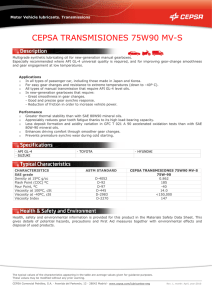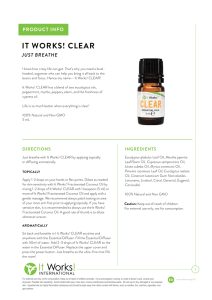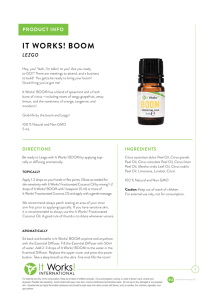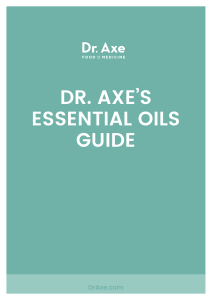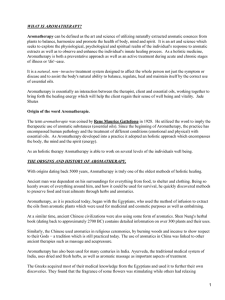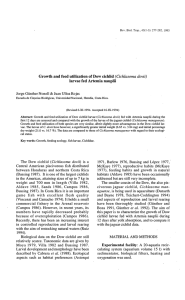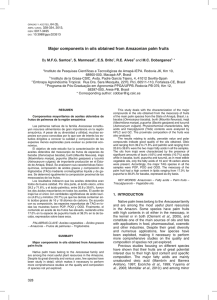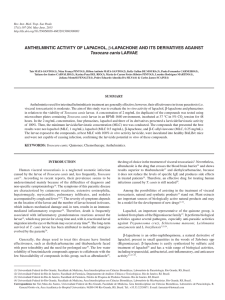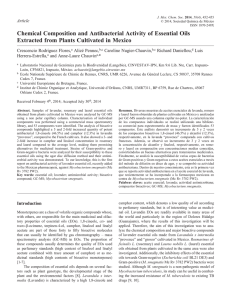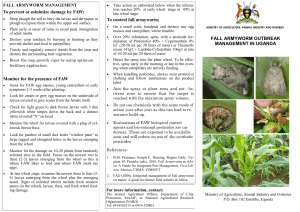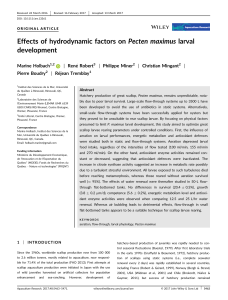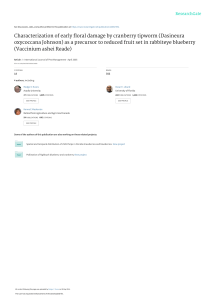In vitro antibacterial effect of exotic plants essential oils on the
Anuncio
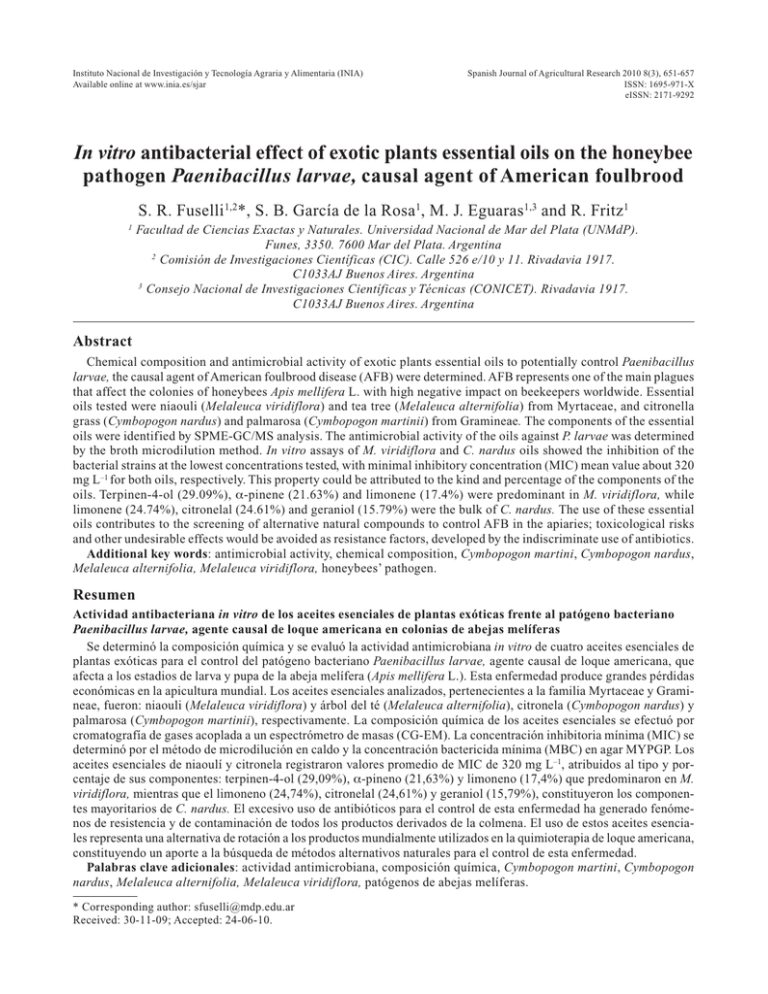
Instituto Nacional de Investigación y Tecnología Agraria y Alimentaria (INIA) Available online at www.inia.es/sjar Spanish Journal of Agricultural Research 2010 8(3), 651-657 ISSN: 1695-971-X eISSN: 2171-9292 In vitro antibacterial effect of exotic plants essential oils on the honeybee pathogen Paenibacillus larvae, causal agent of American foulbrood S. R. Fuselli1,2*, S. B. García de la Rosa1, M. J. Eguaras1,3 and R. Fritz1 1 Facultad de Ciencias Exactas y Naturales. Universidad Nacional de Mar del Plata (UNMdP). Funes, 3350. 7600 Mar del Plata. Argentina 2 Comisión de Investigaciones Científicas (CIC). Calle 526 e/10 y 11. Rivadavia 1917. C1033AJ Buenos Aires. Argentina 3 Consejo Nacional de Investigaciones Científicas y Técnicas (CONICET). Rivadavia 1917. C1033AJ Buenos Aires. Argentina Abstract Chemical composition and antimicrobial activity of exotic plants essential oils to potentially control Paenibacillus larvae, the causal agent of American foulbrood disease (AFB) were determined. AFB represents one of the main plagues that affect the colonies of honeybees Apis mellifera L. with high negative impact on beekeepers worldwide. Essential oils tested were niaouli (Melaleuca viridiflora) and tea tree (Melaleuca alternifolia) from Myrtaceae, and citronella grass (Cymbopogon nardus) and palmarosa (Cymbopogon martinii) from Gramineae. The components of the essential oils were identified by SPME-GC/MS analysis. The antimicrobial activity of the oils against P. larvae was determined by the broth microdilution method. In vitro assays of M. viridiflora and C. nardus oils showed the inhibition of the bacterial strains at the lowest concentrations tested, with minimal inhibitory concentration (MIC) mean value about 320 mg L–1 for both oils, respectively. This property could be attributed to the kind and percentage of the components of the oils. Terpinen-4-ol (29.09%), α-pinene (21.63%) and limonene (17.4%) were predominant in M. viridiflora, while limonene (24.74%), citronelal (24.61%) and geraniol (15.79%) were the bulk of C. nardus. The use of these essential oils contributes to the screening of alternative natural compounds to control AFB in the apiaries; toxicological risks and other undesirable effects would be avoided as resistance factors, developed by the indiscriminate use of antibiotics. Additional key words: antimicrobial activity, chemical composition, Cymbopogon martini, Cymbopogon nardus, Melaleuca alternifolia, Melaleuca viridiflora, honeybees’ pathogen. Resumen Actividad antibacteriana in vitro de los aceites esenciales de plantas exóticas frente al patógeno bacteriano Paenibacillus larvae, agente causal de loque americana en colonias de abejas melíferas Se determinó la composición química y se evaluó la actividad antimicrobiana in vitro de cuatro aceites esenciales de plantas exóticas para el control del patógeno bacteriano Paenibacillus larvae, agente causal de loque americana, que afecta a los estadios de larva y pupa de la abeja melífera (Apis mellifera L.). Esta enfermedad produce grandes pérdidas económicas en la apicultura mundial. Los aceites esenciales analizados, pertenecientes a la familia Myrtaceae y Gramineae, fueron: niaouli (Melaleuca viridiflora) y árbol del té (Melaleuca alternifolia), citronela (Cymbopogon nardus) y palmarosa (Cymbopogon martinii), respectivamente. La composición química de los aceites esenciales se efectuó por cromatografía de gases acoplada a un espectrómetro de masas (CG-EM). La concentración inhibitoria mínima (MIC) se determinó por el método de microdilución en caldo y la concentración bactericida mínima (MBC) en agar MYPGP. Los aceites esenciales de niaoulí y citronela registraron valores promedio de MIC de 320 mg L–1, atribuidos al tipo y porcentaje de sus componentes: terpinen-4-ol (29,09%), α-pineno (21,63%) y limoneno (17,4%) que predominaron en M. viridiflora, mientras que el limoneno (24,74%), citronelal (24,61%) y geraniol (15,79%), constituyeron los componentes mayoritarios de C. nardus. El excesivo uso de antibióticos para el control de esta enfermedad ha generado fenómenos de resistencia y de contaminación de todos los productos derivados de la colmena. El uso de estos aceites esenciales representa una alternativa de rotación a los productos mundialmente utilizados en la quimioterapia de loque americana, constituyendo un aporte a la búsqueda de métodos alternativos naturales para el control de esta enfermedad. Palabras clave adicionales: actividad antimicrobiana, composición química, Cymbopogon martini, Cymbopogon nardus, Melaleuca alternifolia, Melaleuca viridiflora, patógenos de abejas melíferas. * Corresponding author: [email protected] Received: 30-11-09; Accepted: 24-06-10. 652 S. R. Fuselli et al. / Span J Agric Res (2010) 8(3), 651-657 Introduction One of the main plagues that affects the colonies of honeybees Apis mellifera L. is the spore forming bacterium Paenibacillus larvae (Genersch et al., 2006). This pathogen is the causal agent of American fouldbrood (AFB), with high negative impact on beekeepers worldwide. This plague is usually controlled with antibiotics which could leave toxic residues in honey and by-products (Dorman and Deans, 2000; Mc Kee, 2004) and that have already generated resistance phenomena in certain areas of Europe, USA, Canada, Argentina and Asia (Alippi and Reynaldi, 2006). The urge to develop alternative treatment strategies follows three different directions; being one of them the treatment with natural antibacterial substances like essential oils of various plants (Genersch, 2009). Plant essential oils have been studied for their antimicrobial activity against microorganisms, including many pathogens (Dorman and Deans, 2000; Delaquis et al., 2002). In vitro antibacterial, antifungical and miticide activity of some essential oils have shown effective results in the control of bee pests (Calderone and Shimanuki, 1994; Alippi et al., 1996; Floris et al., 1996; Bazzoni and Floris, 1999; Albo et al., 2001, 2003; Ruffinengo et al., 2002, 2005, 2006; Dellacasa et al., 2003; Eguaras et al., 2005; Fuselli et al., 2006, 2007) offering a natural desirable alternative to antibiotics and other synthetic chemical substances. The family Myrtaceae has at least 3,000 species distributed in 130-150 genera, with a wide distribution in tropical and warm-temperate regions of the world. Many plant essential oils belonging to Myrtaceae species, such as Melaleuca alternifolia and Melaleuca viridiflora, have been reported to have insecticidal, antifungal and nematicidal bioactivity (Lee et al., 2008). Tea tree oil (TTO) is a volatile essential oil derived mainly from the Australian native plant M. alternifolia, produced by steam distillation of the leaves and terminal branches. This oil is largely employed for its antimicrobial properties due to the compound terpinen4-ol. It is incorporated as the active ingredient in many topical formulations used to treat infections (Carson et al., 2006) and as alternative natural fungicide (Terzi et al., 2007). Niaouli oil is extracted from M. viridiflora (also known as Melaleuca quinquenervia). This evergreen tree is native to Australia, New Caledonia and the French Pacific Islands and its oil is extracted from the young leaves and twigs by steam distillation. It is useful against enteritis, dysentery, intestinal parasites, cystitis, urinary infections and used to rheumatism and neuralgia. Niaouli oil is considered safe oil, since it is non-toxic, non-irritant and non-sensitizing (Aqil et al., 2007). Some herbaceal plant species belonging to the genus Cymbopogon (Fam Gramineae) are of great commercial importance, between them citronella grass (C. nardus) and palmarosa (C. martini), which are used for making perfumes, soaps, cosmetics, household products and pharmaceutical products. Citronella grass is well known by its repellent effect to control plagues (Orozco Montoya et al., 2006) while palmarosa oil has been shown to be an effective insect repellent when applied to stored grain and beans (Kumar et al., 2007), and as antihelmintic and an antifungal repellent (Kumaran et al., 2003). This work evaluates the in vitro bioactivity of tea tree (M. alternifolia Cheel.), niaouli (M. viridiflora Soland.), citronella grass [C. nardus (L.) Rendle] and palmarosa (C. martinii Stapf.) oils to control Paenibacillus larvae bee pest. Material and methods Essential oils were commercially obtained from Flora SRL, Lorenzana (Pisa), Italy. Gas chromatography combined with mass spectrometry (GC-MS)-Solid phase microextraction (SPME) analyses were carried out to characterize and identify essential oils according to Fuselli et al. (2008b). GC/MS analyses were made by triplicate replication and the results are reported as GC peak area percentage. P. larvae strains were isolated from honey combs of hives exhibiting clinical symptoms of American foulbrood, belonging to different areas of Buenos Aires Province (Argentina), i.e. Miramar (38°15’S-57°50’W), Balcarce (37°52’S-58°15’W), Vidal (37°27’S-57°44’W), Coyunco (37°56’S-57°47’W), Chapadmalal (38°03’S57°42’W), La Plata (34°58’S-57°54’W), Vivoratá (37°40’S-57°42’W), H. Ascasubi (39°22’S-62°39’W), Mechongué (38°09’S-59°13’W) and Mar de Cobo (37°40’S-57°19’W). Isolation and strains identification were done using previously described techniques Abbreviations used: AFB (American fouldbrood), GC-MS (gas chromatography combined with mass spectrometry), MBC (minimal bactericide concentration), MIC (minimal inhibitory concentration), SPME (solid phase microextraction), TTO (tea tree oil). Susceptibility of P. larvae to exotic plant essential oils (Gordon et al., 1973; Alippi, 1991, 1992) and were confirmed afterwards according to biochemical and physiological tests (Jelinski, 1985) and API CH50 kits (Api System, BioMérieux S.A., Marcy l’Étoile, Lyon, France). Reference strain of P. larvae from culture collections (ATCC 9545, from Istituto Nazionale di Apicoltura (INA), Italy) was also considered. The different strains of P. larvae were stored at –20°C on MYPGP agar (Mueller-Hinton broth-yeast extractglucose-sodium piruvate and PO4HK2), with 20% v/v of glycerol until used. The minimal inhibitory concentration (MIC) of the oils against the bacterial strains was determined by broth microdilution method. MIC of oxytetracycline was also determined in parallel experiments in order to control the sensitivity of the microorganisms tested. To perform the broth microdilution method, 100 µL of brain heart infusion broth (Difco Laboratories, 3.7% supplemented 0.1 mg mL –1 thiamine hydrochloride) (Shimanuki and Knox, 1991) separately autoclaved to a final concentration of 0.5% v/v was placed in each of the 96-well microtitre plates. One hundred µL from a stock solution of each exotic essential oil suspended in distilled water and emulsified with 5% v/v propylene glycol (1-2 propanediol) (The Merck Index, 1996), was added to the first well microtitre plate. Twofold serial dilution of each essential oil was carried out in the following nine microtitres plates. The eleventh microtitre plate was the growth control (brain heart infusion broth + propylene glycol) and the twelfth one the sterility control (brain heart infusion broth + propylene glycol+ test oil). One hundred microliters of microbial biomass suspension with density of 107-108 cells mL–1 (FDA, 1998), were added to the well microtitre plates. Microbial biomass suspension was prepared from vegetative cells of P. larvae cultured under microaerobic conditions at 36 ± 0.5°C on MYPGP agar for 48 h. Microtitre plates were incubated under microaerobic conditions at 36 ± 0.5°C for 72 h. The bacterial growth was indicated by the presence of a «white pellet» on the well microtitre plate bottom. From MIC negative microtitre plate, i.e. bacterial growth not visually observed as «white pellet», 100 µL were transferred on MYPGP solid agar (Dingman and Stahly, 1983). These media were incubated at 36 ± 0.5°C for 48 h, under microaerobic conditions, in order to determine minimal bactericide concentration (MBC) values. The antimicrobial activity analyses for four essential oils and ten P. larvae strains were repeated six times for each essential oil (N = 240). MIC and MBC data 653 obtained from the essential oils were comparatively analysed using Fisher exact test, suited for small samples, and then used to estimate signif icant differences (P < 0.05) between bacterial strains. Tuckey’s mean separation test for MIC and MBC of the essential oils was also estimated (StatSoft, 2000). Results and discussion Twenty six compounds representing between 86.9% and 97.4% of the total peak area of the headspace were identif ied in the exotic essential oils considered. GC/MS analysis revealed that for C. martinii and C. nardus the largely predominant specific components are the oxygenated monoterpenes, meanwhile for M. alternifolia and M. viridiflora predominant components are monoterpenes, with percentages between 76.4% and 57.0%, respectively (Table 1). The major constituents of the oil of C. martinii are geraniol (37.4%), geranyl acetate (22.9%) and (E)-βocimene (19.6%). C. nardus had two largely predominant specific components, citronelal and limonene, with similar percentage values about 25%. M. alternifolia oil is principally comprised by p-cymene (24.2%), α-terpinene (12.8%) and α-pinene (11.3%). The main components of M. viridiflora are α-pinene (21.6%), limonene (17.4%) and terpinen-4-ol (29.1%) (Table 1). The characterization of P. larvae strains indicated that they were Gram positive and catalase negative. They did not hydrolyze starch or produce indole. The substrates that allowed differentiate bacterial strains of P. larvae using API CH50, were fructose (negative), aesculin (negative) and D-tagatose (positive). The overall response from these three carbohydrates and the other techniques used allowed identifying the strains correctly. All P. larvae strains were highly susceptible to citronella grass (C. nardus) and to niaouli (M. viridiflora) with MIC and MBC mean values about 320 and 590 mg L–1, respectively. The other two essential oils tested, tea tree (M. alternifolia) and palmarosa (C. martinii), showed lower antibacterial activity with MIC and MBC mean values higher than 1,100 and 1,200 mg L–1, respectively (Table 2). Relationships between MIC and MBC values and the bacterial strains were found (P < 0.05). Tukey’s means separation test for MIC and MBC values indicated that the essential oil of citronella grass (C. nardus) and 654 S. R. Fuselli et al. / Span J Agric Res (2010) 8(3), 651-657 Table 1. Composition of the head space of exotic essential oils (Gramineae and Myrtaceae) as revealed by the SPME-GC/MS technique. The data are reported as percentage of the area of each peak respect to the total peak area Essential oils Compounds C. martinii Monoterpenes α-pinene β-pinene β-myrcene α-terpinene limonene (Z)-β-ocimene (E)-β-ocimene γ-terpinene p-cymene terpinolene Total C. nardus 2.13 1.51 4.12 19.56 Oxigenated monoterpenes 1,8-cineol citronelal geranial linalool terpinen-4-ol α-terpineol geraniol nerol Total 24.74 1.64 1.13 27.32 27.51 4.51 24.61 4.12 1.44 37.39 41.90 15.79 6.17 52.13 5.19 6.42 Sesquiterpenes cariofileno cadineno (+)-ledeno aromadendreno Total 5.19 Esters citronyl acetate geranyl acetate Total 22.98 22.98 6.42 M. alternifolia M. viridiflora 11.32 2.04 1.61 12.79 2.93 21.63 7.30 3.36 1.15 17.40 14.84 24.18 6.73 76.44 3.40 1.40 1.40 57.04 2.03 2.18 4.28 29.09 8.07 6.31 39.34 1.13 1.40 1.68 4.21 2.37 2.37 Cetones 6-metil-5-hepten-2-ona 4-nonanona Total 2.83 1.02 3.85 Total peak area 97.39 92.08 86.96 96.38 Table 2. Mean values of the antimicrobial activity (MIC and MBC expressed as mg L–1) of four exotic essential oils against ten bacterial strains of Paenibacillus larvae, coming from different areas of Buenos Aires Province, Argentina (N = 240) MIC MBC C. martinii C. nardus M. alternifolia M. viridiflora 1,194.9 1,207.7 318.6 594.9 1,094.9 1,187.2 331.4 584.9 Susceptibility of P. larvae to exotic plant essential oils 655 Table 3. Tuckey’s mean separation test for minimal inhibitory concentration (MIC) and minimal bactericide concentration (MBC), expressed as mg L–1, of four exotic essential oils against ten bacterial strains of P. larvae, arranged in decreasing order MIC C. martinii M. alternifolia M. viridiflora C. nardus W0.05 = 93.4 W0.01 = 124.3 MBC C. martinii M. alternifolia C. nardus M. viridiflora W0.05 = 18.4 W0.01 = 145.8 C. martinii M. alternifolia M. viridiflora C. nardus — 100,0 863.5 876.3 + — 763.5 776.3 ++ ++ — 12.8 ++ ++ ns — C. martinii M. alternifolia C. nardus M. viridiflora — 20.5 612.8 622.8 + — 592.3 602.3 ++ ++ — 10.0 ++ ++ ns — Tukey’s critical values (W) are given for α = 0.05 and α = 0.01. ++: highly significant difference. +: significant difference. ns: no significant difference. niaouli (M. viridiflora) were different from the other two essential oils tested (α < 0.01) and were no different between them in their response against the bacterial strains (Table 3). There is not literature about the efficacy of citronella grass and niaouli essential oils to control AFB, though there are previous studies about the use of natural products against the causative agent of this disease (Eguaras et al., 2005; Fuselli et al., 2006, 2007, 2008a,b, 2009; Gende et al., 2008, 2009). Citronella grass and niaouli essential oils showed good antimicrobial activity, comparable to that reported by Alippi et al. (1996) for savory (Satureja hortensis) and oregano (Origanum vulgare) essential oils, with similar MIC values ranging from 250-450 mg L –1 and to Artemisia absinthium, A. annua and Lepechinia floribunda oils with MIC mean values of 416.7 mg L–1, 401.9 mg L–1 and 393.6 mg L–1, respectively (Fuselli et al., 2008b). All P. larvae strains showed a certain degree of sensibility to citronella grass and niaouli oils, though bacterial inhibition could be attributed to the volatile constituents of the two largely predominant specific components of C. nardus, limonene and citronelal and to the main components of M. viridiflora, which are α-pinene, limonene and terpinen-4-ol. The use of essential oils against microbial strains allows an alternative scope for the control of this serious disease, affecting honey and its by-products. These results contribute to the screening of alternative natural compounds for treating honeybee colonies suffe- ring from AFB, and may have significant implications in the future to be incorporated in an integrated management programme. Acknowledgments This research was supported by Comisión de Investigaciones Científicas (CIC) de la Provincia de Buenos Aires, grant Res. Nº 673/07. References ALBO G.N., CERIMELE E., RE M.S., DE GIUSTI M.R., ALIPPI A.M., 2001. Ensayos de campo para evaluar la efectividad de algunos aceites esenciales. Vida Apícola 108, 41-46. [In Spanish]. ALBO G.N., HENNING C.P., RINGUELET J.A., REYNALDI F.J., DE GIUSTI M.R., ALIPPI A.M., 2003. Evaluation of some essential oils for the control and prevention of American foulbrood disease in honey bees. Apidologie 34, 1-10. ALIPPI A.M., 1991. A comparison of laboratory techniques for the detection of significant bacteria of the honey bee, Apis mellifera in Argentina. J Apicult Res 30, 75-80. ALIPPI A.M., 1992. Detección de Bacillus larvae en poblaciones mixtas de esporas bacterianas a partir de restos larvales. Microbiol SEM 8, 115-118. [In Spanish]. ALIPPI A.M., RINGUELET J.A., CERIMELE E.L., RE M.S., HENNING C.P., 1996. Antimicrobial activity of some essential oils against Paenibacillus larvae, the causal 656 S. R. Fuselli et al. / Span J Agric Res (2010) 8(3), 651-657 agent of American foulbrood disease. J Herbs Spices Med Plants 4(2), 9-16. ALIPPI A.M., REYNALDI F.J., 2006. Inhibition of the growth of Paenibacillus larvae, the causal agent of American foulbrood of honeybees, by selected strains of aerobic spore-forming bacteria isolated from apiarian sources. J Invertebr Pathol 91, 141-146. AQIL M., AHAD A., SULTANA Y., ALI A., 2007. Status of terpenes as skin penetration enhancers. Drug Discov Today 12(23/24), 1061-1067. BAZZONI E., FLORIS I. 1999. Azione in vitro di diversi oli essenzali contro Paenibacillus larvae e Ascosphaera apis. Atti Apilombardia 98, 191-197. [In Italian]. CALDERONE N.W., SHIMANUKI H., 1994. An in vitro evaluation of botanical compounds for the control of the honeybee pathogens Bacillus larvae and Ascosphera apis and the secondary invader B. alvei. J Essent Oil Res 6, 279-287. CARSON C.F., HAMMER K.A., RILEY T.V., 2006. Melaleuca alternifolia (tea tree) oil: a review of antimicrobial and other medicinal properties. Clin Microbiol Rev 19, 50-62. DELAQUIS P.J., STANICH K., GIRARD B., MAZZA G., 2002. Antimicrobial activity of individual and mixed fractions of dill, cilantro, coriander and eucalyptus essential oils. Int J Food Microbiol 74(1-2), 101-109. DELLACASA A.D., BAILAC P.N., PONZI M.I., RUFFINENGO S.R., EGUARAS M.J., 2003. In vitro activity of essential oils from San Luis-Argentina against Ascosphaera apis. J Essent Oil Res 15, 282-285. DINGMAN D.W., STAHLY D.P., 1983. Medium promoting sporulation of Bacillus larvae and metabolism of medium components. Appl Environ Microb 46, 860-869. DORMAN H.J.D., DEANS S.G., 2000. Antimicrobial agents from plants, antibacterial activity of plant volatile oils. J Applied Microbiol 88, 308-316. EGUARAS M., FUSELLI S., GENDE L., FRITZ R., RUFFINENGO S., CLEMENTE G., GONZÁLEZ A., BAILAC P., PONZI M., 2005. An in vitro evaluation of Tagetes minuta essential oil for the control of the honeybee pathogens Paenibacillus larvae and Ascosphaera apis, and the parasitic mite Varroa destructor. J Essent Oil Res 17(3), 336-340. FDA, 1998. App.3.73. Bacteriological analytical manual, 8th ed. Food and Drug Administration, AOAC International, Gaithersburg, MD, USA. 581 pp. FLORIS I., CARTA C., MORETTI M., 1996. Activités in vitro de plusieurs huiles essentielles sur Bacillus larvae White et essai au rucher. Apidologie 2, 111-119. [In French]. FUSELLI S.R., GARCÍA DE LA ROSA S.B., GENDE L.B., EGUARAS M.J., FRITZ R., 2006. Antimicrobial activity of some Argentinean wild plant essential oils against Paenibacillus larvae larvae, causal agent of American foulbrood (AFB). J Apicult Res 45(1), 2-7. FUSELLI S.R., GARCÍA DE LA ROSA S.B., EGUARAS M.J., FRITZ R., NDAGIJIMANA M., VANNINI L., GUERZONI M.E., 2007. Efficacy of indigenous plant essential oil Andean thyme (Acantholippia seriphioides A. Gray) to control American foulbrood (AFB) in honey bee (Apis mellifera L.) hives. J Essent Oil Res 19, 501-506. FUSELLI S.R., GARCÍA DE LA ROSA S.B., EGUARAS M.J., FRITZ R., 2008a. Chemical composition and antimicrobial activity of citrus essences on honeybee bacterial pathogen Paenibacillus larvae, the causal agent of American foulbrood. World J Microbiol Biotechnol 24, 2067-2072. FUSELLI S.R., GARCÍA DE LA ROSA S.B., EGUARAS M., FRITZ R., 2008b. Susceptibility of the honeybee bacterial pathogen Paenibacillus larvae to essential oils distilled from exotic and indigenous Argentinean plants. J Essent Oil Res 20, 464-470. FUSELLI S.R., MAGGI M., GARCÍA DE LA ROSA S., PRINCIPAL J., EGUARAS M., FRITZ R., 2009. In vitro antibacterial and antiparasitic effect of citrus fruit essential oils on the honeybee pathogen Paenibacillus larvae and the parasitic mite Varroa destructor. J Apicul Res 48(1), 77-78. GENDE L.B., FLORIS I., FRITZ R., EGUARAS M.J., 2008. Antimicrobial activity of cinnamon (Cinnamomum zeylanicum) essential oil and its main components against Paenibacillus larvae from Argentine. Bull Insectology 61(1), 1-4. GENDE L., BAILAC P., MAGGI M., PONZI M., EGUARAS M.J., FRITZ R., 2009. Antimicrobial activity of Pimpinella anisum and Foeniculum vulgare essential oils against Paenibacillus larvae subsp. larvae. J Essent Oil Res 21, 91-93. GENERSCH E., 2009. American Foulbrood in honeybees and its causative agent, Paenibacillus larvae. J Invertebr Pathol 103(Suppl 1), S10-S19. GENERSCH E., FORSGREN E., PENTIKÄINEN J., ASHIRALIEVA A., RAUCH S., KILWINSKI J., FRIES I., 2006. Reclassification of Paenibacillus larvae subsp. pulvifaciens and Paenibacillus larvae subsp. larvae as Paenibacillus larvae without subspecies differentiation. Int J Syst Evol Microbiol 56, 501-511. GORDON R.E., HAYNES W.C., PANG H.N., 1973. The genus Bacillus. Agricultural Handbook No. 427, USDA, Washington DC, USA. JELINSKI M., 1985. Some biochemical properties of Bacillus larvae White. Apidologie 16, 69-76. KUMAR R., SRIVASTAVA M., DUBEY N.K., 2007. Evaluation of C. martinii oil extract for control of postharvest insect deterioration in cereals and legumes. J Food Protect 70(1), 172-178. KUMARAN A.M., D’SOUZA P., AGARWAL A., BOKKOLLA R.M., BALASUBRAMANIAM M., 2003. Geraniol, the putative anthelmintic principle of Cymbopogon martini. Phytother Res 17(8), 957. LEE Y.S., KIM J., SHIN S.C., LEE S.G., PARK I.K., 2008. Antifungal activity of Myrtaceae essential oils and their components against three phytopathogenic fungi. Flavour Fragr J 23, 23-28. McKEE B., 2004. Contamination issues for honey in Australia. Workshop International of Quality Honey, Quality assurance manager, Capilano Group of Companies, Rafaela, Santa Fé, Argentina, 24-29 September. Susceptibility of P. larvae to exotic plant essential oils OROZCO MONTOYA J., SOTO GIRALDO A., DE SOUSA A.H., 2006. Efecto de repelencia de Crotalaria juncea, Galactia striata y Cymbopogon nardus para el manejo de Cyrtomenus bergi (Hemiptera Cydnidae). Revista de Biologia e Ciências da Terra 6(2), 179-184. [In Spanish]. RUFFINENGO S.R., EGUARAS M.J., CORA D. , RODRÍGUEZ E., BEDASCARRASBURE E., BAILAC P.N., PONZI M.I., 2002. Biological activity of Heterotheca latifolia essential oil against Varroa jacobsoni. J Essent Oil Res 14, 462-464. RUFFINENGO S.R., EGUARAS M.J., FLORIS I., FAVERÍN C., BAILAC P.N., PONZI M.I., 2005. LD50 and repellent effect of essential oils from Argentinean wild plant species on Varroa destructor. J Economic Entomol 98, 651-655. RUFFINENGO S.R., MAGGI M., FUSELLI S., FLORIS I., CLEMENTE G., FIRPO N.H., BAILAC P.N., PONZI 657 M.I., 2006. Laboratory evaluation of Heterothalamus alienus essential oil against different pests of Apis mellifera. J Essent Oil Res 18, 704-707. TERZI V., MORCIA C., FACCIOLI P., VALE G., TACCONI G., MALNATI M., 2007. In vitro antifungal activity of the tea tree (Melaleuca alternifolia) essential oil and its major components against plant pathogens. Lett Appl Microbiol 44, 613-618. SHIMANUKI H., KNOX D.A., 1991. Diagnosis of honey bee diseases. Agriculture Handbook AH-690, USDA, Springfield, VA, USA. STATSOFT, 2000. Statistica user’s guide, Statistica for Windows, Version 6.0. Statsoft, Tulsa, OK, USA. THE MERCK INDEX, 1996. Encyclopedia of chemicals, drugs, and biologicals. 12th ed. Merck Research Laboratories, Division of Merck & Co, Inc Whitehouse Station, NJ, USA.
